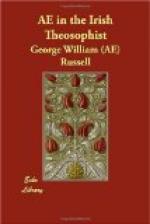“Look, and you will see it is the palace of a god.”
Perhaps the mystic warriors of the Red Branch saw supernatural pillars blazoned like the sunset, and entered through great doors and walked in lofty halls with sunset-tinted beings speaking a more beautiful wisdom than earth’s. And they there may have seen those famous gods who had withdrawn generations before from visible Eire: Manannan the dark blue king, Lu Lamfada with the sunrise on his brow and his sling, a wreath of rainbow flame, coiled around him, the Goddess Dana in ruby brilliance, Nuada silver-handed, the Dagda with floating locks of light shaking from him radiance and song, Angus Oge, around whose head the ever-winging birds made music, and others in whose company these antique heroes must have felt the deep joy of old companionship renewed, for were not the Danann hosts men of more primeval cycles become divine and movers in a divine world. In the Brugh too was a fountain, to what uses applied the mystical imagination working on other legends may make clearer.
The Well of Connla, the parent fountain of many streams visible and invisible, was the most sacred well known in ancient Ireland. It lay itself below deep waters at the source of the Shannon, and these waters which hid it were also mystical, for they lay between earth and the Land of the Gods. Here, when stricken suddenly by an internal fire, the sacred hazels of wisdom and inspiration unfolded at once their leaves and blossoms and their scarlet fruit, which falling upon the waters dyed them of a royal purple; the nuts were then devoured by Fintann the Salmon of Knowledge, and the wisest of the druids partook also. This was perhaps the greatest of the mysteries known to the ancient Gael, and in the bright phantasmagoria conjured up there is a wild beauty which belongs to all their tales. The suddenly arising dreams of a remote divinity, the scarlet nuts tossing on the purple flood, the bright immortals glancing hither and thither, are pictures left of some mystery we may not now uncover, thought tomorrow may reveal it, for the dawn-lights are glittering everywhere in Ireland. Perhaps the strange woman who spoke of the well at Ballykeele, and the others like her, may know more about these fountains than the legend-seekers who so learnedly annoted their tales. They may have drunken in dreams of the waters at Connla’s well, for many go to the Tir-na-nog in sleep, and some are said to have remained there, and only a vacant form is left behind without the light in the eyes which marks the presence of a soul. I make no pretence of knowledge concerning the things which underlie their simple speech, but to me there seems to be for ever escaping from legend and folk-tale, from word and custom, some breath of a world of beauty I sigh for but am not nigh to as these are. I think if that strange woman could have found a voice for what was in her heart she would have completed her vague oracle somewhat as I have done:




